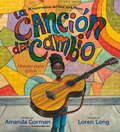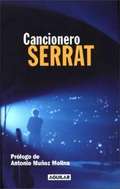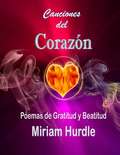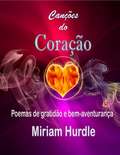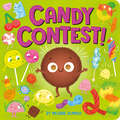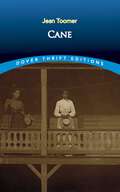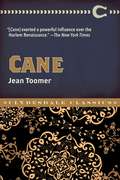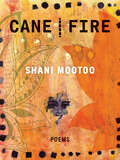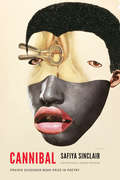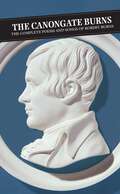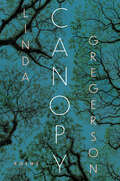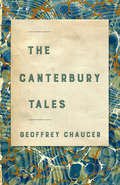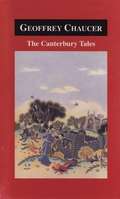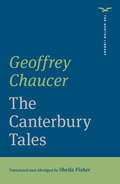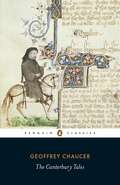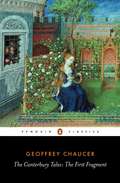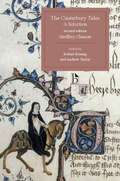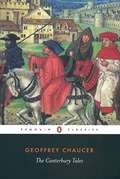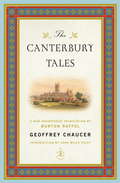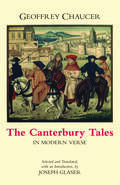- Table View
- List View
Cancer Poetry
by Iain TwiddyThis is the first critical study to offer a sustained analysis of the theme of cancer in contemporary poetry. In discussing works by major poets, including Paul Muldoon, Jo Shapcott and Christopher Reid, Cancer Poetry traces the complex ways in which poets represent cancer, and assesses how poetry can be instrumental to emotional recovery.
La canción del cambio: Himno para niños
by Amanda GormanUn lírico libro debut para niños por la poeta inaugural presidencial Amanda Gorman y el ilustrador #1 superventas del New York Times Loren Long."Escucho el zumbido del cambio.Es una ruidosa y orgullosa canción.No temo la llegada del cambio y por eso canto con gran pasión." En este emocionante y anticipado libro para niños por la poeta inaugural presidencial y activista, Amanda Gorman, todo es posible cuando nuestras voces se unen. Cuando una niña guía a un elenco de personajes por un viaje musical, ellos aprenden que tienen el poder de hacer cambios - grandes o pequeños - en el mundo, en sus comunidades y sobre todo dentro de ellos mismos. Ilustrado por el renombrado Loren Long, El cambio canta usa texto lírico e ilustraciones rítmicas que llegan a un crescendo deslumbrante, y es la llamada triunfal a la acción a todos para que usen sus habilidades para hacer una diferencia.
Cancionero de Serrat
by Joan Manuel SerratCompilación de las canciones del poeta catalán, en cuyo prólogo el escritor Antonio Muñoz Molina dice: Tete Montoliú, que fue uno de los más altos músicos que hemos tenido en España, amaba hondamente las canciones de Serrat, e hizo versiones exquisitas de algunas de ellas. Despojadas de la letra y de la voz que canta, resumidas en la musicalidad abstracta del piano, las canciones muestran su médula simple y poderosa, que es el misterio de ese arte, tan sutil y tan cercano a la vida usual que los entendidos a veces no acaban de verle el mérito, del mismo modo que los aficionados podemos disfrutarlo con una relajada falta de atención, como se disfrutan, por cierto, algunos de los grandes placeres de la vida (...) "...Si el tiempo, en el fondo, es la materia y el tema de casi todas o de todas las artes, en la canción el tiempo está en un estado de concentración máxima, de pureza absoluta, y es por eso por lo que puede afectarnos tanto: el niño escucha en la radio una canción y se emociona por cosas que ignora, y vislumbra ante sí el tiempo futuro de su vida, y le parece que siente la hondura de un pasado que para él aún es muy breve. Las canciones abren anchas avenidas de tiempo, perspectivas de lejanía hacia el ayer y el mañana, despiertan en nosotros el eco de lo que sabemos que somos y también el de lo que podríamos ser o haber sido(...) La poesía de lo cotidiano, la búsqueda de la belleza, de la vivencia del encuentro y la libertad, las emociones de siempre. "Una buena canción requiere dos clases de talento: el talento de intuir una forma breve y en apariencia simple en la que ha de caber comprimida la complejidad de un relato y la inmediatez de una sensación, de un estado de ánimo; y también el talento de intuir la naturaleza del tiempo en el que uno vive, no de contarlo, sino de expresarlo en su tonalidad específica, de atraparlo en su fugacidad como se fija un aroma en un frasco de perfume...."
Canciones Del Corazón: Poemas de Gratitud y Beatitud
by Miriam HurdlePoemas de gratitud y beatitud Canciones del Corazón es una colección de poesía basada en las verdaderas experiencias de Miriam Hurdle. Canciones del Corazón toca la melodía melancólica del sufrimiento y trasciende a la melodía de la serenidad y la paz. Es un camino recorrido con optimismo, esperanza y aprecio en medio de circunstancias de dolor y un cáncer impredecible. También celebra el amor verdadero y las relaciones satisfactorias. Hurdle en su colección de poesía incluye nueve temas: Canciones de la Naturaleza, Canciones de Disonancia, Canciones de Curación física, Canciones de Matrimonio, Canciones de Paternidad, Canciones de Tributo, Canciones de Reflexion, Canciones de Desafío y Canciones de Inspiración. Cada uno de estos temas cubre varios aspectos de su experiencia de vida. Muchos poemas están ilustrados con sus fotos y acuarelas. Los poemas de esta colección son inspiradores para la mente, el corazón y el espíritu. Los lectores harán eco con estas experiencias.
Canções do coração: Poemas de gratidão e bem-aventurança
by Miriam HurdleCanções do coração toca a melancólica melodia do sofrimento e transcende a melodia da serenidade e da paz. É um caminho percorrido com otimismo, esperança e apreço em meio a situações de dor no coração e um câncer imprevisível. Ele também celebra o amor verdadeiro e a realização dos relacionamentos.. Hurdle em sua coleção de poesia inclui nove temas: Canções da Natureza, Canções de Dissonância, Canções de Cura Física, Canções de Casamento, Canções de Paternidade, Canções de Tributo, Canções de Reflexões, Canções de Desafio e Canções de Inspiração. Cada um desses temas abrange vários aspectos de sua experiência de vida. Muitos poemas são ilustrados com suas fotos e pinturas em aquarela. Os poemas desta coleção são inspiradores para a mente, coração e espírito. Os leitores ecoarão com essas experiências.
Cançons impossibles
by Marc ParrotEl cantant i compositor Marc Parrot, ens endinsa en el seu mon particular gràcies als seus poemes. Il·lustrat per Ohiane Inchaustegui M'he dedicat a compondre cançons des d'abans de ser qui havia de ser. Ho he fet sempre com una necessitat que em porta a resoldre no sé ben bé què, com tampoc sé del cert d'on sorgeix. Potser és només que explicar-me representaria una petita conquesta de mi mateix: fer-me meu a còpia d'aquests intents juganers, més o menys encertats. L'objectiu inconscient es va revelant com una mena de premi: la consciència per gaudir més del que ja sé i que em fa veure el que desconec com quelcom més interessant. I ja estic preparat per llançar tot el que he escrit al foc.
Candy: Poems (Sewanee Poetry)
by Dan AlbergottiDan Albergotti’s Candy is a book steeped in sound and silence. Sound in the form of song, of chaotic cacophony, and of the drone (sometimes natural, sometimes manufactured) that creates the ambient soundtrack of history and the seemingly apocalyptic present. Silence in the sense both of the void’s innate quietude and of the failure to speak—of people either dumbstruck or in denial, not speaking because they cannot or will not. Throughout this collection, these sounds and intermittent silences provide the rhythm for poems that question the nature of truth and myth, and that restlessly search for meaning in a reticent universe, ultimately unwilling to take no for an answer as they strive to find an ever-elusive yes.
Candy Contest!
by Melanie DemmerThis board book celebrates candy, friendship, and the differences that make us unique... "because the world is sweeter when everyone shines bright!"In this book, various candies in a bowl are competing to see who's best: Chocolates fight over who is most creamy.Marshmallows and Marzipan each say they&’re dreamy.Taffy and Caramel tumble, tug, and stick,while Butterscotch and Lemon Drop fall, roll, and kick. When tensions rise and their contest turns sour, Peanut Butter Cup reminds the candies that they each have their own talent and flavor. In the end, the candies realize that their friendship is what matters most, and they agree to stop fighting. This sturdy board book features rhyming text and colorful art from a New York Times bestselling illustrator. Full of humor and heart, it's a perfect gift for toddlers, and a great spark for discussions about diversity and inclusion.
Cane (Dover Thrift Editions #0)
by Jean Toomer"[Cane] has been reverberating in me to an astonishing degree. I love it passionately; could not possibly exit without it." — Alice Walker "A breakthrough in prose and poetical writing …. This book should be on all readers' and writers' desks and in their minds." — Maya Angelou Hailed by critics for its literary experimentation and vivid portrayal of African-American characters and culture, Cane represents one of the earliest expressions of the Harlem Renaissance. Combining poetry, drama, and storytelling, it contrasts life in an African-American community in the rural South with that of the urban North. Author Jean Toomer (1894–1967) drew upon his experiences as a teacher in rural Georgia to create a variety of Southern psychological realism that ranks alongside the best works of William Faulkner. The book's three-part structure, ranging from South to North and back again, is united by its focus on the lives of African-American men and women in a world of bigotry, violence, passion, and tenderness.
Cane (Clydesdale Classics #0)
by Jean Toomer&“Cane . . . exerted a powerful influence over the Harlem Renaissance&”—The New York TimesCane is a collection of short stories, poems, and dramas, written by Harlem Renaissance author Jean Toomer in 1923. The stories focus around African-American culture in both the North and the South during times when racism and Jim Crow laws still abounded. Vignettes of the lives of various African-American characters tell what it was like to live both in the rural areas of Georgia and the urban streets of the northern cities. The book was heralded as an influential part of the Harlem Renaissance and, at the time, influenced artists of every background. Authors, dramatists, and even jazz musicians could find influence and inspiration in the pages of Cane&’s work. Both Zora Neale Hurston and Langston Hughes themselves visited Sparta, Georgia, after reading Toomer&’s work. Unfortunately, the white public did not react well to Cane, and the sales dropped. The book did not become revered as the classic work it is today until the Civil Rights Movement in the 1960s. Now you can read this new edition of what is considered one of the best works of the Harlem Renaissance.
Cane Fire
by Shani MootooFrom internationally celebrated writer and visual artist Shani Mootoo comes Cane | Fire, an immersive and vivid collection that marks a long-awaited return to poetry.Throughout this evocative, sensual collection, akin to a poetic memoir, past and present are in conversation with each other as the narrator moves from Ireland to San Fernando, and finally to Canada. The reinterpretations and translation of this journey and its associated family history give meaning to the present. Through these deeply personal poems, and Mootoo's own artwork, we begin to understand how a life can not only be shaped, but even reimagined.
Cannibal (Prairie Schooner Book Prize in Poetry)
by Safiya SinclairColliding with and confronting The Tempest and postcolonial identity, the poems in Safiya Sinclair’s Cannibal explore Jamaican childhood and history, race relations in America, womanhood, otherness, and exile. She evokes a home no longer accessible and a body at times uninhabitable, often mirrored by a hybrid Eve/Caliban figure. Blooming with intense lyricism and fertile imagery, these full-blooded poems are elegant, mythic, and intricately woven. Here the female body is a dark landscape; the female body is cannibal. Sinclair shocks and delights her readers with her willingness to disorient and provoke, creating a multitextured collage of beautiful and explosive poems.
The Canongate Burns: The Complete Poems And Songs Of Robert Burns (Canongate Classics #24)
by Robert BurnsThis &“magnificent and authoritative work&” presents the complete verse of Scotland&’s National Bard with extensive textual and historical notes (Colm Toibin, The Independent, UK). Best known for poems such as &“A Red, Red Rose&” and &“Ae Fond Kiss,&” and for the song &“Auld Lang Synge,&” which is sung around the world every New Years&’ Eve, Robert Burns was one of the most important poets of the 18th century. A major influence on the Romantic poetry movement, Burns is still beloved across Scotland, with Burns Night celebrated every January 25th. This complete volume of the writer&’s poetry and songs includes previously unpublished pieces, draws on extensive scholarship and Burn&’s own letters, and offers supplemental information about his life, early hardships, political beliefs, and literary contexts. An extensive glossary of Scots words is included.&“A very fine edition, and the long introduction, which sets out to clear the tangled banks, is alone worth the cover price.&”—The Scotsman, UK
Canopy: Poems
by Linda GregersonA long-awaited yet startlingly urgent new collection from &“a contemporary master&”*—a fierce, big-hearted eye on our last, tumultuous decade, and our fragile environment *Los Angeles Review of Books Linda Gregerson&’s long-awaited new collection is a tour de force, a compendium of lives touched by the radical fragility of the planet and, ultimately, the endless astonishment and paradox of being human within the larger ecosystem, &“in a world where every breath I take is luck.&” From the Syrian refugee and ecological crises, to police brutality and COVID, to the Global Seed Vault buried under permafrost, the poems ask: How does consciousness relate to the individual body, the individual to the communal, the community to our environment? How do we mourn a loved one, and how do we mourn strangers? The magnificent poems in Canopy catalogue and reckon with humanity and the natural world, mortality, rage, love, grief, and survival.
The Canterbury Tales
by Geoffrey ChaucerWhile Geoffrey Chaucer composed several magnificent works of poetry, his reputation as “the father of English literature” rests mainly on The Canterbury Tales, a group of stories told by assorted pilgrims en route to the shrine of Thomas à Becket in Canterbury Cathedral. From the mirthful and bawdy to the profoundly moral, the tales, taken in their entirety, reflect not only the manners and mores of medieval England, but indeed, the full comic and tragic dimensions of the human condition. Considered the greatest collection of narrative poems in English literature, The Canterbury Tales was composed in the Middle English of Chaucer’s day, possibly to be read aloud at the court of Richard II. However, their grandeur, humor, and relevance are timeless, as readers of this authoritative edition will discover.Penguin Random House Canada is proud to bring you classic works of literature in e-book form, with the highest quality production values. Find more today and rediscover books you never knew you loved.
The Canterbury Tales
by Geoffrey ChaucerWhile Geoffrey Chaucer composed several magnificent works of poetry, his reputation as “the father of English literature” rests mainly on The Canterbury Tales, a group of stories told by assorted pilgrims en route to the shrine of Thomas à Becket in Canterbury Cathedral. <P><P>From the mirthful and bawdy to the profoundly moral, the tales, taken in their entirety, reflect not only the manners and mores of medieval England, but indeed, the full comic and tragic dimensions of the human condition. <P><P>Considered the greatest collection of narrative poems in English literature, The Canterbury Tales was composed in the Middle English of Chaucer’s day, possibly to be read aloud at the court of Richard II. <P><P>However, their grandeur, humor, and relevance are timeless, as readers of this authoritative edition will discover. <P><P>Penguin Random House Canada is proud to bring you classic works of literature in e-book form, with the highest quality production values. Find more today and rediscover books you never knew you loved.
The Canterbury Tales (Enriched Classic)
by Geoffrey ChaucerThe procession that crosses Chaucer's pages is as full of life and as richly textured as a medieval tapestry. The Knight, the Miller, the Friar, the Squire, the Prioress, the Wife of Bath, and others who make up the cast of characters -- including Chaucer himself -- are real people, with human emotions and weaknesses. When it is remembered that Chaucer wrote in English at a time when Latin was the standard literary language across western Europe, the magnitude of his achievement is even more remarkable. But Chaucer's genius needs no historical introduction; it bursts forth from every page of "The Canterbury Tales."
The Canterbury Tales (The Norton Library #0)
by Geoffrey ChaucerAbout Sheila Fisher’s translation Preserving Chaucer’s rhyme and meter, Sheila Fisher’s vivid, lively, and readable translation makes the poetic artistry of The Canterbury Tales accessible to a contemporary ear and invites readers, even those who have read the work before in Middle English, to a new appreciation of its delightful stories and unforgettable, surprisingly modern characters.
The Canterbury Tales
by Geoffrey ChaucerAt the Tabard Inn in Southwark, a jovial group of pilgrims assembles, including an unscrupulous Pardoner, a noble-minded Knight, a ribald Miller, the lusty Wife of Bath, and Chaucer himself. As they set out on their journey towards the shrine of Thomas a Becket in Canterbury, each character agrees to tell a tale. The twenty-four tales that follow are by turns learned, fantastic, pious, melancholy and lewd, and together offer an unrivalled glimpse into the mind and spirit of medieval England.
The Canterbury Tales: The First Fragment
by Geoffrey ChaucerThe most complete of all remaining surviving fragments sections of The Canterbury Tales, the First Fragment contains some of Chaucer's most widely enjoyed work. In The General Prologue, Chaucer introduces his pilgrims through a set of speaking portraits, drawn with a clarity that makes no attempt to conceal their peculiarities. The four tales that follow - those of the Knight, Miller, Reeve and Cook - reveal a wide variety of human preoccupations: whether chivalrous, romantic or simply sexual. Brilliantly bawdy and subtly complex, each of these tales is alive with Chaucer's skills as a poet, storyteller and creator of comedy.
The Canterbury Tales: A Selection
by Geoffrey Chaucer Robert Boenig Andrew TaylorDrawing from the same text as the complete Broadview edition of the Tales, which is based on the famous Ellesmere Manuscript, this selected edition also features a critical introduction, marginal glosses in modern English of difficult words, and explanatory footnotes. The most widely taught appendix material from the complete edition is included, along with ten illustrations from the Ellesmere Manuscript. The second edition includes a new glossary, a timeline of Chaucer’s life and times, and detailed headers showing the section and line numbers, making it easier to find a specific section of the poem. Several popular prologues and tales have also been added to the selection: The Cook’s Prologue and Tale, The Friar’s Prologue and Tale, The Merchant’s Prologue and Tale, and The Parson’s Prologue.
The Canterbury Tales (Penguin Clothbound Classics Ser.)
by Geoffrey Chaucer Nevill CoghillNevill Coghill's masterly and vivid modern English verse translation with all the vigor and poetry of Chaucer's fourteenth-century Middle English In The Canterbury Tales Chaucer created one of the great touchstones of English literature, a masterly collection of chivalric romances, moral allegories and low farce. A story-telling competition between a group of pilgrims from all walks of life is the occasion for a series of tales that range from the Knight's account of courtly love and the ebullient Wife of Bath's Arthurian legend, to the ribald anecdotes of the Miller and the Cook. Rich and diverse, The Canterbury Tales offer us an unrivalled glimpse into the life and mind of medieval England. For more than sixty-five years, Penguin has been the leading publisher of classic literature in the English-speaking world. With more than 1,500 titles, Penguin Classics represents a global bookshelf of the best works throughout history and across genres and disciplines. Readers trust the series to provide authoritative texts enhanced by introductions and notes by distinguished scholars and contemporary authors, as well as up-to-date translations by award-winning translators.
The Canterbury Tales
by Geoffrey Chaucer Burton RaffelLively, absorbing, often outrageously funny, Chaucer's The Canterbury Tales is a work of genius, an undisputed classic that has held a special appeal for each generation of readers. The Tales gathers twenty-nine of literature's most enduring (and endearing) characters in a vivid group portrait that captures the full spectrum of medieval society, from the exalted Knight to the humble Plowman. This new edition includes a comprehensive introduction that summarizes some of the most important historical events and movements that defined the world of Chaucer and his pilgrims; two additional tales (Reeve's and Shipman's); introductions for each tale designed to prepare the reader for a better understanding and enjoyment of the tale; newly written and conveniently placed explanatory notes; and a new, more easily understood system for learning to pronounce Chaucerian Middle English.From the Paperback edition.
The Canterbury Tales in Modern Verse
by Joseph Glaser Geoffrey ChaucerReaders of this witty and fluent new translation of The Canterbury Tales should find themselves turning page after page: by recasting Chaucer's ten-syllable couplets into eight-syllable lines, Joseph Glaser achieves a lighter, more rapid cadence than other translators, a four-beat rhythm well-established in the English poetic tradition up to Chaucer's time. Glaser's shortened lines make compelling reading and mirror the elegance and variety of Chaucer's verse to a degree rarely met by translations that copy Chaucer beat for beat. Moreover, this translation's full, Chaucerian range of diction--from earthy to Latinate--conveys the great scope of Chaucer's interests and effects.The selection features complete translations of the majority of the stories, including all of the more familiar tales and narrative links along with abridgments or summaries of the others. To reflect Chaucer's interest in poetic technique, Glaser presents the tales written in non-couplet stanzas in their original forms.An Introduction, marginal glosses, bibliography, and notes are also included.
Cántico espiritual: Nueva edición de Lola Josa a la luz de la mística hebrea
by San Juan De la CruzUN ACONTECIMIENTO EDITORIAL SIN PRECEDENTES La edición más completa, libre de la censura católica, del gran poema de la mística castellana Una cárcel denigrante fue el lugar donde se concibió, en 1578, Cántico espiritual, uno de los mayores poemas de la literatura occidental. Ahí permaneció encerrado fray Juan de la Cruz por querer reformar la orden de los carmelitas. Su carcelero le facilitó papel y tinta para escribir, así como aguja e hilo con los que el descalzo pudo coser mantas y trapos para fugarse, llevándose el cuaderno con las primeras treinta y una estrofas de las «Canciones entre el Alma y el Esposo» que había compuesto de memoria en la noche de su encierro. Mediante una metáfora erótica, el poema describía una profunda experiencia mística que se vinculaba con la tradición sapiencial hebrea, buscando la comunión con Dios a través del encuentro con la esencia de la palabra bíblica, tal y como habían propuesto Casiodoro de Reina, autor de la primera y prohibida traducción completa de la Biblia al castellano, o fray Luis de León, probable maestro de fray Juan en Salamanca. En esta nueva y reveladora edición, Lola Josa, especialista en el autor, ha fijado el texto a la luz de la mística hebrea sumergida en el poema, enmendando errores seculares de transmisión y proponiendo una revolucionaria interpretación que, libre de dogmas tanto religiosos como filológicos, da una nueva vida al poema y nos descubre un tesoro oculto de referencias, lecturas y desafíos. La crítica ha dicho...«De todos los hombres que han usado la lengua española para los fines de la poesía, san Juan de la Cruz es el más grande.»Jorge Luis Borges «Poesía es voz de lo inefable. A pocos poetas les ha sido dado tener esa voz. En España la tuvo san Juan de la Cruz.»Juan Ramón Jiménez «¿En qué reside la fuerza de su prodigiosa virtualidad estética que aún hondamente, exquisitamente nos perturba? [...] Es la palabra, el prodigio de la palabra desnuda, en toda su hiriente fuerza de expresión. [...] ¡Velocidad, condensación, desnudez expresiva, prodigio de la palabra en su nitidez original! [...] Quien así escribía, quien podía desarrollar un largo tema con este ímpetu y este refreno, con seguridad clásica y alta llamarada de espíritu, era un perfecto artífice literario.»Dámaso Alonso «San Juan escribió para sí mismo y para unas monjas. Y esa marginalidad le da una libertad que no tuvo ningún poeta culto de su tiempo. Le da la libertad de mezclar la tradición escrituraria, la tradición popular y la tradición grecorromana.»Jaime Gil de Biedma «Los místicos auténticos, como san Juan de la Cruz, describen la operación de la gracia en el alma con precisión de químico o de geólogo.»Simone Weil

